55% of the Amazon may be lost by 2030
55% of the Amazon may be lost by 2030
But carbon-for-conservation initiatives could slow deforestation
Rhett A. Butler, mongabay.com
January 23, 2008
|
|
Cattle ranching, industrial soy farming, and logging are three of the leading drivers of deforestation in the Brazilian Amazon. As commodity prices continue to rise, driven by surging demand for biofuels and grain for meat production, the economic incentives for developing the Amazon increase. Already the largest exporter of beef and the second largest producer of soy — with the largest expanse of “undeveloped” but arable land of any country — Brazil is well on its way to rivaling the U.S. as the world’s agricultural superpower. The trend towards turning the Amazon into a giant breadbasket seems unstoppable.
Nevertheless the decision at the U.N. climate talks in Bali to include “Reducing Emissions From Deforestation and Degradation” (REDD) in future climate treaty negotiations may preempt this fate. The mechanism could lead to the transfer of billions of dollars — in the form of carbon credits — from industrialized countries to tropical nations for the purpose of slowing greenhouse gas emissions by reducing deforestation rates. Deforestation presently accounts for roughly 20 percent of anthropogenic emissions worldwide.
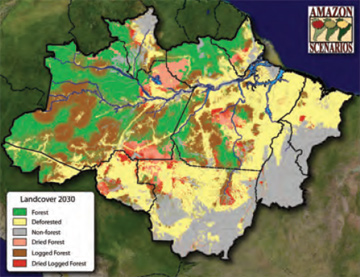 The Brazilian Amazon in 2030, showing drought-damaged, logged, and cleared forests. Th is map assumes that deforestation rates of 1997-2003 continue into the future, and that the climatic conditions of the last 10 years are repeated into the future. From Soares-Filho et al. 2006, Nepstad et al. 2004, 2007, Nepstad and Stickler in press, Merry et al. in review. (See Supplemental Online Material for description of methods at http://whrc.org/Brazilcarbonsupplement |
In a January 2008 conversation with mongabay.com, Dr. Daniel Nepstad, a scientist at the Woods Hole Research Institute, discussed the development implications of REDD in the Amazon. Nepstad said that while it seems inevitable that much of the Amazon will be plowed for cattle pasture and industrial soy farms, careful management of the economic transformation occurring in the region, combined with REDD compensation, could lead to a scenario of zero deforestation in the Amazon. Still, Nepstad cautioned that large-scale changes occurring in the region — chiefly from deforestation, logging, fire, and drought — could portend a difficult future for the Amazon rainforest. New models, to be published next month in the journal Philosophical Transactions, indicate that as much as 55 percent of the Amazon will be either cleared or damaged by 2030, absent of the effects of climate change, which are expected to warm and dry parts of the region. Presently less than 20 percent of the Amazon has been felled.
INTERVIEW WITH DANIEL NEPSTAD
Mongabay: In terms of REDD, what are your thoughts on what was achieved at the U.N. climate talks in Bali?
Nepstad: Bali established a clear path forward for REDD. While there are an amazing number of details that need to be worked out, carbon credits through REDD will provide a major economic incentive to leave forests standing.
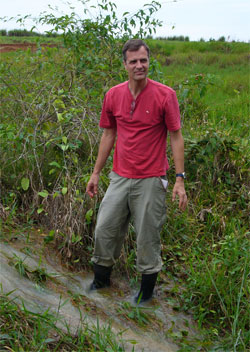 An interview with Dr. Daniel Nepstad: Amazon rainforest at a tipping point But globalization could help save it Despite its scale — the basin covers 40 percent of South America — the Amazon is also one of the fastest changing ecosystems, largely as a result of human activities, including deforestation, forest fires, and, increasingly, climate change. Few people understand these impacts better than Dr. Daniel Nepstad, one of the world’s foremost experts on the Amazon rainforest. Now head of the Woods Hole Research Center’s Amazon program in Belém, Brazil, Nepstad has spent more than 23 years in the Amazon, studying subjects ranging from forest fires and forest management policy to sustainable development. |
One of the key initiatives is the World Bank’s Forest Carbon Partnership Facility. In very little time we’ll have several tropical countries up and running with their own national or sub-national REDD policy.
The World Bank has historically not been very good at designing processes that engage multiple stakeholders in a meaningful way, but the leadership of this program is very much committed to that. Despite the protests and criticism in Bali, the World Bank’s involvement is encouraging.
Mongabay: What groups were protesting REDD?
Nepstad: The groups most worried about REDD are forest people. They are concerned about getting cut off from their forest resources through REDD initiatives and more specifically, through the World Bank. A lot of these groups have been bashing the bank for many years. I cut my teeth in Washington as part of the multi-lateral development bank campaign exposing some of the poor lending policies of the World Bank, but I think at the moment we have to try to make this bank initiative work.
Mongabay: There has been some other World Bank controversy regarding a International Finance Corporation loans in the Amazon, correct?
Nepstad: Yes. The irony is that at the same time the World Bank was launching the Forest Carbon Partnership Facility, the International Finance Corporation [a World Bank agency] was making a loan to the Bertin meat-packing plant in the Brazilian Amazon. The loan aims to set up a sustainable supply of beef for an ecological meat-packing facility in Marabá in the state of Para.
What upset the protestors was the idea that the same institution would be accelerating deforestation by expanding the capacity to process meat in the Amazon region as it creates this mechanism for compensating nations for reducing their emissions. Our own feeling on this is that there comes a point where we have to acknowledge that the region is undergoing an economic transformation and if we can find a powerful lever for commodifying how this transformation takes place — putting a premium on legal land-use practices, legal deforestation, the gradual elimination of the use of fire — we should take it. For me that trumps the negative consequences of setting up increased capacity in the region. In other words, I really do believe that there are many responsible cattle ranchers and soy farmers in the Amazon who are waiting for some sort of recognition through positive incentives. The incentive could be a very small mark up — literally a few cents per pound of beef sold — but it would send a signal to these ranchers that if they want to participate in the new beef economy, they better have their legal forest reserve in order or have compensated for it, maintain or be in the process of restoring their riparian zone forests, control erosion, and get their cows out of the streams and into artificial watering tanks. There is a whole range of positive things that can happen once cattle ranchers see that if they do things right they are rewarded. This means that as Brazil moves forward as the world’s leading exporter of beef — with tremendous potential to expand — we have a way to shape that expansion as it takes place to reduce the negative ecological impacts.
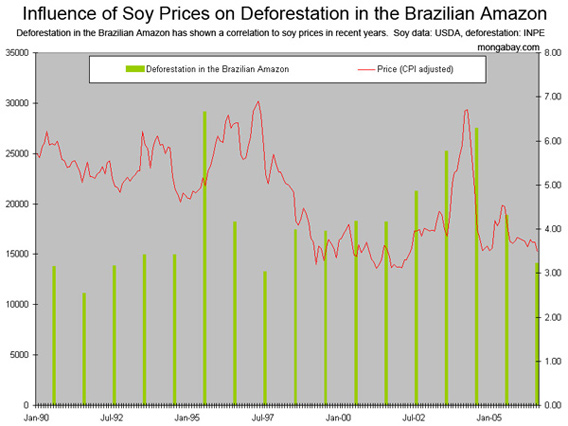 Influence of soybean prices (CPI-adjusted) on deforestation in the Brazilian Amazon. All figures in hectares (2.47 acres). Click to enlarge  Influence of live cattle prices (CPI-adjusted, 12-month moving average) on deforestation in the Brazilian Amazon. While nearly two-thirds of Amazon clearing can be attributed to conversion for cattle pasture, deforestation in the states of Mato Grosso and Para has shown a only a slight correlation to cattle prices in recent years. This could be due, in part, to the use of cattle pasture for land speculation (land prices are rising faster than the value of cattle) and as a hedge against inflation and currency fluctuation. All figures in hectares (2.47 acres). Click to enlarge More at charts 2007 Amazon fires among worst ever |
In other words as beef prices go up, the Amazon cattle herd is rapidly expanding. We don’t see the packing facilities as the limiting factor. We think the capital to build new meat-packing plants is abundant. We saw J&F Participações SA acquire the Swift plant last year, creating a meat-packing facility that meets international standards. There is remarkable liquidity in world markets for making money off land-use. We believe the positive aspects of this investment far outweigh the negative aspects. There may be a short-term pull in new-clearing for cattle pasture, but very quickly thereafter there will be the message that you can only enter into this system if you are playing by the book and doing things legally. That to us is what’s paramount right now.
In our vision, a few things need to happen. First, there needs to be strong market-based incentives for complying with environmental laws and using best land management practices. Second, large areas of forest sitting on soils that are not suitable for cattle ranching need to be set aside for protection. One of our reports released in Bali presents the first map of the potential process, estimating the net present value of every parcel of forest in the Amazon. The profit margins for ranching are tiny over most of the Amazon and ranching is not a good way to use that soil or those forests. This ties into the third major thing that needs to happen. This is intensifying ways to grow and produce cattle so there is less need to clear new land. We’re now seeing some systems that have six head of cattle per hectare per year as opposed to 0.8 which is the region-wide average. So we’re getting an 8-fold increase in grazing intensity that allows the herd to expand without driving further deforestation. We’re moving towards is an era of more expensive beef, greater restrictions on forest-cutting in the Amazon through protected areas, and greater intensification. Cattle are basically expanding together with agroindustry and grain production. Cattle have got to be right next to soy, corn, or sugar cane.
Mongabay: Would carbon credits from REDD beat returns from cattle ranching?
Nepstad: A big question is, “Who would qualify?” If we assume the landowners would qualify for compensation for the opportunity cost of keeping their forests standing and not going to ranching, it’s a fairly small area of forest. We think ranchers should be compensated for the opportunity costs of preserving forest on their land as stipulated by Brazilian law [landowners are required to keep 50-80 percent of their land forested]. However, these landowners should also be paid for maintaining forests in excess of their legal requirement. We think it is very important moving forward that whatever forests are maintained on private property should receive some compensation. This idea was very well received in Bali when we presented this work at a number of venues. We had a meeting with governor Maggi [governor of the Brazilian state of Mato Grosso] and several of leaders of the soy, sugar cane, beef industries from Mato Grosso. Their first question was whether landowners could seek carbon credits as compensation for the price of compliance with Brazilian legislation. If that option is kept on the table then they are big advocates of bringing deforestation to zero. If they don’t see that in there, they could become opponents of REDD.
Mongabay: How do you measure the potential of REDD in comparison with other forms of land use?
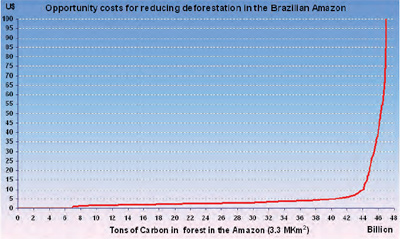 Marginal opportunity cost of reductions in carbon emissions for the Brazilian Amazon. This graph plots the opportunity cost per ton of carbon, as described in Figure 7, from the cheapest to the most expensive emissions reductions. Ninety percent of the opportunity costs are less than $5 and 94% are less than $10. Th e total opportunity cost to maintain the entire forest is $257 billion (if paid all at once in 2007 dollars) for 47 B tons of C; the cost of compensating 94% of the “cheapest” forests is $115 billion, with carbon stocks of 44 billion tons. |
Nepstad: We developed a carbon supply curve looking at the net present value (NPV) of soy and cattle for every forested parcel in the Amazon.
Looking at the lowest NPV lands — those with low potential profit due to poor access to markets, unsuitable soils, and high carbon content — REDD can compensate for ranching at a price of $1-2 per ton of carbon — incredibly cheap. About 94 percent of the Amazon could be compensated at less than $10 per ton of carbon and 90 percent for less than $5 per ton of carbon. So it’s really the 10 percent of forests that are sitting on soils very suitable for soybeans that drive the price, otherwise REDD stays very cheap.
To do this we have several models that interact. One is a spatial model of transportation costs for soybeans that calculates for every spot in the Amazon how much it cost to haul a ton of soybeans to a port. Transportation is probably 40 percent of the cost of growing soybeans in the Amazon and costs are directly tied to roads and distance away from the ports. We have similar models that estimate the costs for timber and cattle. The next thing that comes in is soil suitability. We have previous models — published in the case of soy, in the process of being published for timber and cattle — that show how well a soil type can support that type of production. This is a particularly big issue for soy. Another thing we look at is climate and the length of the dry season. In the case of timber we look at the installed capacity too process timber. So these are pretty complex data-rich models that we have built up over the past several years but really just came to fruition prior to Bali. As far as I know, no one has ever developed such detailed computer models that allow you to map out based upon soils, topography, roads, urban centers, deforestation areas, how the potential profitability varies across the landscape.
Mongabay: As improvements are made to highway BR-163, will changes in profitability be reflected on the map?
Nepstad: Yes. Let’s say you have 100 hectares of forest and you are thinking about converting it for soybeans. Really the price of that land should reflect its potential for generating profits in the future, or its net present value. We estimate the net present value for every plot of forest by summing up the future profit from that land activity and factoring in a schedule of highway paving. The profitability of that plot of forest goes up in the future as the BR-163 is completed and every year thereafter the profitability remains higher. So this is really a very interesting platform for doing policy-relevant simulations about future economic activity. You can model the impact when you pave the roads, the price of carbon needed to keep the forest standing, the cost of protected areas in terms of creating scarcity of land available for forest conversion. The model can handle all of these factors at the same time.
Mongabay: Will policy makers and developers have access to these models?
Nepstad: The model is as good the data available, but it can be applied to an individual rancher, by asking him for his numbers. How much does it take for you to a truckload of cows to the nearest slaughter house? What is your price of mineral salts — incidentally mineral salts are the main cost of doing business as a rancher? Then you can run the model for that ranch.
Really the goal of this study as we released it in Bali is to show we can calculate these things. With these calculations, we can estimate the overall cost of REDD taking deforestation to zero on the scale of the Amazon. The next step is to work closely with governments in an iterative process where they suggest some ideas that we integrate into the model. We’ll run the model and then we sit down with policymakers, ranchers, and soy farmers so we have buy-in from everyone involved in this whole process of planning the future of the Amazon with a zero deforestation scenario. The model is a tool for allowing us to have a sort of a crystal ball to look at the implications of having different approaches to REDD.
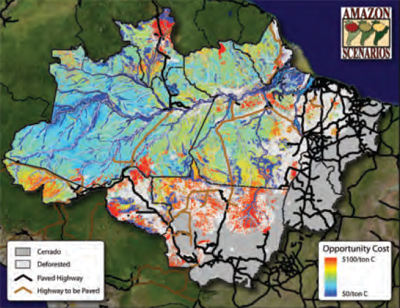 Net opportunity cost of forest protection in the Brazilian Amazon. Calculated as maximum net present value of soy or cattle production minus NPV of timber. The value was then divided by forest carbon stocks. Red represents high opportunity costs for foregoing land-use activities. |
You can see this when you look at the map [published in “The Costs and Benefits of Reducing Carbon Emissions from Deforestation and Forest Degradation in the Brazilian Amazon,” a report released in Bali]. The Xingu basin in the southeast is bright red, reflecting a REDD opportunity cost of around $100 per ton of carbon because that region is flat as a pancake, has good highways around it, and is very close to processing facilities, making it idea for soy cultivation. Most of that red is inside the Xingu indigenous reserve. In other words, those Indians could really be seen as the guardians of the forest for keeping it standing against the economic interests. The state is supposed to take care of the reserve, but in fact the Indians do a perfect job in that region. This is a classical example of Brazil forgoing economic activity on that land. It needs to be compensated. The Indians who live in the Xingu park need to be compensated. So that’s where REDD comes in.
If you look at chart on page 22 of the report, it shows the minimum cost to compensate Indians and other forest people — the Public Forest Stewardship of Forest People Fund. This is basically doubles their family income and makes it viable to live in the forest.
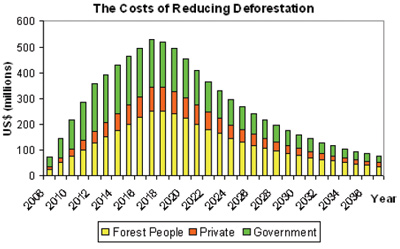 Example of the estimated costs of the Public Forest Stewardship Fund (Forest People), the Private Forest Stewardship Fund, and the Government Fund over a thirty-year period using the premises set forth in the Amazon report. The proposed REDD program would have direct impacts on the livelihoods of 200,000 low-income rural families, including all of the indigenous and traditional families of the Brazilian Amazon. Th ese families would more than double their incomes as they shift to forest-based economic activities. Th ey would also receive $700 per family per year in added educational, health, and technical support services. |
We’ve also estimated the opportunity costs that will go straight to private landholders as well as what the government needs to increase its capacity to monitor and enforce public lands. You can see that the lion’s share of this fund once you get out 10 years goes to forest people. This gets back to the protestors out in front of the World Bank in Bali. A response to that is look at the indigenous groups in the Amazon. They very much want REDD. They want to be at the table and negotiate REDD to make sure that they are not cut off from their forest resources.
The report is designed to quantify what it would cost to compensate fairly those stakeholders who have a fair and just claim for compensation in moving toward zero deforestation.
Mongabay: Earlier you mentioned the crop suitability report released by the Woods Hole Research Institute at Bali. Anything that you would like to highlight?
Nepstad: If we think of palm oil, sugar cane, and soy as the main sources of biofuel moving forward, where is it going to go? What we did is map out the suitable soils for each of those three crops around the world and looked at the forests that sit on those soils and how much carbon they contain. In a nutshell, what we found is that about five countries contain 70 percent of tropical forest carbon. More importantly, 40 percent of the forest carbon is on soils suitable for biofuel crops — most of this is in Brazilian Amazon. The findings reinforce the idea that the Brazil is really the leading country for biofuel crop and grain expansion in the tropics. The potential for biofuels to become the largest driver for deforestation is quite large.
Mongabay: What are your thoughts on the E. U.’s decision to ban imports of certain biofuels produced on native forest lands? Do you agree that this seems to be creating an expanding a market for eco-certified biofuels?
Nepstad: Yes, definitely. It’s just like the Greenpeace soy campaign back in 2004 which sent such a big signal. I’ll be in Buenos Aires in the first week of February as part of the working group for the global soy certification process. Soy importers from Europe were telling us that in our last meeting. And yet there is a lot of resistance from producers to the idea of saying: “We will not cut native forests to grow soy”. With palm oil, that concept is already in there. Under palm oil certification you can’t have cut native forests to grow palm after November 2005 and get certified. So that will be a big issue and hopefully China will be out in the cold in a few years and will have to move towards these certified sources.
Mongabay: In Bali you also put out some rather dire projections for the Amazon in 2030. Could you elaborate on this?
Nepstad: There are all these models (namely the Hadley model) pointing to the end of the century when there will be a big forest die-back in the Amazon. But before global warming is going to kick in there is going to be all sorts of damage from the droughts we are already seeing as well as deforestation, logging, and the fires that are part of that regime. To factor in these effects, we took our deforestation model, our logging model, and what we know about the effect of drought on tree mortality, and projected out the year 2030 using current climate patterns — the last 10 years repeated into the future. We found that by the year 2030, 55 percent of the forest will be either cleared or damaged — I think 31 percent cleared and 24 percent damaged by either logging or drought, with a large portion of that damaged forest catching fire. This produces a huge amount of emissions. We’re looking at 16-25 billion tons of carbon going into the atmosphere in a very short time frame — the next 22 years. The scary thing is some of these assumptions are quite conservative.
Related articles
Amazon deforestation could be eliminated with carbon priced at $3. Study finds that more than 90 percent of the opportunity costs of Amazon forest conservation could be compensated for a per-ton carbon value of $3. Simply eliminating deforestation would cost about $1.2 per ton of carbon.
-
Daniel Nepstad (2007). The Costs and Benefits of Reducing Carbon Emissions from Deforestation and Forest Degradation in the Brazilian Amazon [PDF]. The Woods Hole Research Center. United Nations Framework Convention on Climate Change (UNFCCC) Conference of the Parties (COP), Thirteenth session. 3-14 December 2007
Tropical forests face huge threat from industrial agriculture. With forest conversion for large-scale agriculture rapidly emerging as a leading driver of tropical deforestation, a new report from the Woods Hole Research Center (WHRC) suggests the trend is likely to continue with Brazil, the Democratic Republic of the Congo, Indonesia, Peru, and Colombia containing 75 percent of the world’s forested land that is highly suitable for industrial agriculture expansion. Nevertheless the study identifies forests that may be best suited (low population density, unsuitable climate and soils) for “Reduced Emissions from Deforestation and Degradation” (REDD) initiatives which compensate countries for preserving forest lands in exchange for carbon credits.
-
Claudia Stickler et al (2007). Readiness For Redd: A Preliminary Global Assessment Of Tropical Forested Land Suitability For Agriculture [PDF]. The Woods Hole Research Center. United Nations Framework Convention on Climate Change (UNFCCC) Conference of the Parties (COP), Thirteenth session. 3-14 December 2007
Returns from carbon offsets could beat palm oil in Congo DRC. A proposal to pay the Democratic of Congo (DRC) for reducing deforestation could add 15-50 percent to the amount of international aid given to the warn-torn country, reports a new study published by scientists at the Woods Hole Research Center (WHRC). The funds would help alleviate rural poverty while cutting emissions of greenhouse gases and protecting threatened biodiversity.
-
Laporte, N. et al (2007). Reducing CO2 emissions from deforestation and forest degradation in the Democratic Republic of the Congo [PDF]. Presented by the Woods Hole Research Center at the United Nations Framework Convention on Climate Change (UNFCCC) Conference of the Parties (COP), Thirteenth session 3-14 December 2007 in Bali, Indonesia.
New satellite system will penetrate clouds to track deforestation. Satellite monitoring will play a critical role in any agreement that compensates tropical countries for preserving their forests, such as “Reduced Emissions from Deforestation and Degradation” (REDD) mechanisms currently under discussion at UN climate talks in Bali. Released Tuesday, a new study, “New Eyes in the Sky: Cloud-Free Tropical Forest Monitoring for REDD with the Japanese Advanced Land Observation Satellite (ALOS)”, details significant advancements in the field of remote sensing of forests.
-
Josef Kellndorfer (2007). New Eyes in the Sky: Cloud-Free Tropical Forest Monitoring for REDD with the Japanese Advanced Land Observation Satellite (ALOS) [PDF]. The Woods Hole Research Center. United Nations Framework Convention on Climate Change (UNFCCC) Conference of the Parties (COP), Thirteenth session. 3-14 December 2007
Global warming accelerates destruction of the Amazon. Deforestation and climate change could damage or destroy as much as 60 percent of the Amazon rainforest by 2030, according to a new report from environmental group WWF.
Related interviews
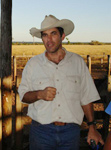
|
John Cain Carter, founder of Brazilian NGO Aliança da Terra Cattle ranchers and soy farmers could save the Amazon — 06/06/2007 John Cain Carter, a Texas rancher who moved to the the Brazilian state of Mato Grosso 11 years ago and founded what is perhaps the most innovative organization working in the Amazon, Aliança da Terra, believes the only way to save the Amazon is through the market. Carter says that by giving producers incentives to reduce their impact on the forest, the market can succeed where conservation efforts have failed. What is most remarkable about Aliança’s system is that it has the potential to be applied to any commodity anywhere in the world. That means palm oil in Borneo could be certified just as easily as sugar cane in Brazil or sheep in New Zealand. By addressing the supply chain, tracing agricultural products back to the specific fields where they were produced, the system offers perhaps the best market-based solution to combating deforestation. Combining these approaches with large-scale land conservation and scientific research offers what may be the best hope for saving the Amazon. |
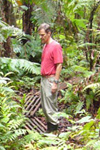 |
Dr. Daniel Nepstad, Director of the Woods Hole Research Center’s Amazon program Amazon rainforest at a tipping point but globalization could help save it — 06/04/2007 The Amazon basin is home to the world’s largest rainforest, an ecosystem that supports perhaps 30 percent of the world’s terrestrial species, stores vast amounts of carbon, and exerts considerable influence on global weather patterns and climate. Few would dispute that it is one of the planet’s most important landscapes. Despite its scale the Amazon is also one of the fastest changing ecosystems, largely as a result of human activities, including deforestation, forest fires, and, increasingly, climate change. Few people understand these impacts better than Dr. Daniel Nepstad, one of the world’s foremost experts on the Amazon rainforest. Now head of the Woods Hole Research Center’s Amazon program in Belém, Brazil, Nepstad has spent more than 23 years in the Amazon, studying subjects ranging from forest fires and forest management policy to sustainable development. Nepstad says the Amazon is presently at a point unlike any he’s ever seen, one where there are unparalleled risks and opportunities. While he’s hopeful about some of the trends, he knows the Amazon faces difficult and immediate challenges. |